A Two-Level Early Warning System on Urban Floods Caused by Rainstorm
Abstract
1. Introduction
2. Methodology
2.1. Structure of the EWS
2.2. Model Construction
2.2.1. Hydrodynamic Method
2.2.2. The National Model
2.2.3. The Urban Model
2.3. Early Warning Rules
3. Application Effects
3.1. National Early Warnings
3.2. Urban Early Warnings
3.2.1. Reasonableness Analysis
3.2.2. Flood Warning Applications
4. Discussion and Conclusions
Author Contributions
Funding
Institutional Review Board Statement
Informed Consent Statement
Data Availability Statement
Conflicts of Interest
References
- Xu, T. Permeability Control and Flood Risk Assessment of Urban Underlying Surface: A Case Study of Runcheng South Area, Kunming. Nat. Hazards 2022, 111, 661–686. [Google Scholar] [CrossRef]
- Liu, W.; Feng, Q.; Engel, B.A.; Yu, T.; Zhang, X.; Qian, Y. A Probabilistic Assessment of Urban Flood Risk and Impacts of Future Climate Change. J. Hydrol. 2023, 618, 129267. [Google Scholar] [CrossRef]
- Hallegatte, S.; Green, C.; Nicholls, R.J.; Corfee-Morlot, J. Future Flood Losses in Major Coastal Cities. Nat. Clim. Change 2013, 3, 802–806. [Google Scholar] [CrossRef]
- Chang, L.-C.; Liou, J.-Y.; Chang, F.-J. Spatial-Temporal Flood Inundation Nowcasts by Fusing Machine Learning Methods and Principal Component Analysis. J. Hydrol. 2022, 612, 128086. [Google Scholar] [CrossRef]
- Balaian, S.K.; Sanders, B.F.; Abdolhosseini Qomi, M.J. How Urban Form Impacts Flooding. Nat. Commun. 2024, 15, 6911. [Google Scholar] [CrossRef]
- Wüthrich, D.; Korswagen, P.A.; Selvam, H.; Oetjen, J.; Bricker, J.; Schüttrumpf, H. Field Survey Assessment of Flood Loads and Related Building Damage from the July 2021 Event in the Ahr Valley (Germany). J. Flood Risk Manag. 2014, 18, e13024. [Google Scholar] [CrossRef]
- Okunola, O.H.; Werners, S.E. A Multi-Dimensional Framework for Assessing Disaster Recovery Pathways: Lessons and Experiences from Germany and Nigeria. Int. J. Disaster Risk Reduct. 2024, 112, 104777. [Google Scholar] [CrossRef]
- Yang, Q.; Zhang, S.; Dai, Q.; Yao, R. Assessment of Community Vulnerability to Different Types of Urban Floods: A Case for Lishui City, China. Sustainability 2020, 12, 7865. [Google Scholar] [CrossRef]
- He, J.; Qiang, Y.; Luo, H.; Zhou, S.; Zhang, L. A Stress Test of Urban System Flooding upon Extreme Rainstorms in Hong Kong. J. Hydrol. 2021, 597, 125713. [Google Scholar] [CrossRef]
- Wu, Z.; Zheng, X.; Chen, Y.; Huang, S.; Hu, W.; Duan, C. Urban Flood Loss Assessment and Index Insurance Compensation Estimation by Integrating Remote Sensing and Rainfall Multi-Source Data: A Case Study of the 2021 Henan Rainstorm. Sustainability 2023, 15, 11639. [Google Scholar] [CrossRef]
- Wang, P.; Li, Y.; Yu, P.; Zhang, Y. The Analysis of Urban Flood Risk Propagation Based on the Modified Susceptible Infected Recovered Model. J. Hydrol. 2021, 603, 127121. [Google Scholar] [CrossRef]
- Liang, Y.; Liao, W.; Zhang, Z.; Li, H.; Wang, H. Using a Multiphysics Coupling-Oriented Flood Modelling Approach to Assess Urban Flooding under Various Regulation Scenarios Combined with Rainstorms and Tidal Effects. J. Hydrol. 2024, 645, 132189. [Google Scholar] [CrossRef]
- Zhao, G.; Xu, Z.; Pang, B.; Tu, T.; Xu, L.; Du, L. An Enhanced Inundation Method for Urban Flood Hazard Mapping at the Large Catchment Scale. J. Hydrol. 2019, 571, 873–882. [Google Scholar] [CrossRef]
- Wu, Z.; Zhou, Y.; Wang, H.; Jiang, Z. Depth Prediction of Urban Flood under Different Rainfall Return Periods Based on Deep Learning and Data Warehouse. Sci. Total Environ. 2020, 716, 137077. [Google Scholar] [CrossRef]
- Qi, W.; Ma, C.; Xu, H.; Zhao, K. Urban Flood Response Analysis for Designed Rainstorms with Different Characteristics Based on a Tracer-Aided Modeling Simulation. J. Clean. Prod. 2022, 355, 131797. [Google Scholar] [CrossRef]
- Wang, P.; Li, Y.; Zhang, Y. An Urban System Perspective on Urban Flood Resilience Using SEM: Evidence from Nanjing City, China. Nat. Hazards 2021, 109, 2575–2599. [Google Scholar] [CrossRef]
- Xu, T.; Xie, Z.; Jiang, F.; Yang, S.; Deng, Z.; Zhao, L.; Wen, G.; Du, Q. Urban Flooding Resilience Evaluation with Coupled Rainfall and Flooding Models: A Small Area in Kunming City, China as an Example. Water Sci. Technol. 2023, 87, 2820–2839. [Google Scholar] [CrossRef] [PubMed]
- Chen, Y.; Zhou, H.; Zhang, H.; Du, G.; Zhou, J. Urban Flood Risk Warning under Rapid Urbanization. Environ. Res. 2015, 139, 3–10. [Google Scholar] [CrossRef]
- Zhou, Y.; Wu, Z.; Xu, H.; Wang, H. Prediction and Early Warning Method of Inundation Process at Waterlogging Points Based on Bayesian Model Average and Data-Driven. J. Hydrol. Reg. Stud. 2022, 44, 101248. [Google Scholar] [CrossRef]
- Yang, B.; Qian, Y.; Chen, L.; Li, J.; Huang, L.; Zhu, F. Research and Application of Urban Waterlogging Monitoring and Early Warning System. China Water Wastewater 2024, 40, 107–112. [Google Scholar]
- Cao, X.; Qi, Y.; Li, M.; Yang, Z.; Ni, G. Early Warning System of Urban Waterlogging under the Threat of Extreme Rainfall Events. Chin. J. Atmos. Sci. 2022, 46, 953–964. [Google Scholar] [CrossRef]
- Mei, C.; Shi, H.; Liu, J.; Song, T.; Wang, J.; Gao, X.; Wang, H.; Li, M. Analyzing Urban Form Influence on Pluvial Flooding via Numerical Experiments Using Random Slices of Actual City Data. J. Hydrol. 2024, 633, 130916. [Google Scholar] [CrossRef]
- Li, C.; Liu, M.; Hu, Y.; Wang, H.; Zhou, R.; Wu, W.; Wang, Y. Spatial Distribution Patterns and Potential Exposure Risks of Urban Floods in Chinese Megacities. J. Hydrol. 2022, 610, 127838. [Google Scholar] [CrossRef]
- Chen, G.; Hou, J.; Zhou, N.; Yang, S.; Tong, Y.; Su, F.; Huang, L.; Bi, X. High-Resolution Urban Flood Forecasting by Using a Coupled Atmospheric and Hydrodynamic Flood Models. Front. Earth Sci. 2020, 8, 545612. [Google Scholar] [CrossRef]
- Zhang, H.; Wu, W.; Hu, C.; Hu, C.; Li, M.; Hao, X.; Liu, S. A Distributed Hydrodynamic Model for Urban Storm Flood Risk Assessment. J. Hydrol. 2021, 600, 126513. [Google Scholar] [CrossRef]
- Mohamadiazar, N.; Ebrahimian, A.; Hosseiny, H. Integrating Deep Learning, Satellite Image Processing, and Spatial-Temporal Analysis for Urban Flood Prediction. J. Hydrol. 2024, 639, 131508. [Google Scholar] [CrossRef]
- Wu, Z.; Zhou, Y.; Wang, H. Real-Time Prediction of the Water Accumulation Process of Urban Stormy Accumulation Points Based on Deep Learning. IEEE Access 2020, 8, 151938–151951. [Google Scholar] [CrossRef]
- Li, X.; Yu, Y.; Wang, C.; Zheng, S.; Li, L.; Chen, G. Monitoring and Characterization of the Entire Urban Flooding Process in the Typical Southern Plain River Network Area. J. Hydraul. Eng. 2022, 53, 845–853. [Google Scholar] [CrossRef]
- Zheng, Y.; Jing, X.; Lin, Y.; Shen, D.; Zhang, Y.; Yu, M.; Zhou, Y. Research on Nowcasting Prediction Technology for Flooding Scenarios Based on Data-Driven and Real-Time Monitoring. Water Sci. Technol. 2024, 89, 2894–2906. [Google Scholar] [CrossRef]
- Chen, W.; Wu, H.; Kimball, J.S.; Alfieri, L.; Nanding, N.; Li, X.; Jiang, L.; Wu, W.; Tao, Y.; Zhao, S.; et al. A Coupled River Basin-Urban Hydrological Model (DRIVE-Urban) for Real-Time Urban Flood Modeling. Water Resour. Res. 2022, 58, e2021WR031709. [Google Scholar] [CrossRef]
- Zang, Y.; Meng, Y.; Guan, X.; Lv, H.; Yan, D. Study on Urban Flood Early Warning System Considering Flood Loss. Int. J. Disaster Risk Reduct. 2022, 77, 103042. [Google Scholar] [CrossRef]
- Su, X.; Shao, W.; Liu, J.; Jiang, Y.; Wang, K. Dynamic Assessment of the Impact of Flood Disaster on Economy and Population under Extreme Rainstorm Events. Remote Sens. 2021, 13, 3924. [Google Scholar] [CrossRef]
- Wang, H.; Hu, Y.; Guo, Y.; Wu, Z.; Yan, D. Urban Flood Forecasting Based on the Coupling of Numerical Weather Model and Stormwater Model: A Case Study of Zhengzhou City. J. Hydrol. Reg. Stud. 2022, 39, 100985. [Google Scholar] [CrossRef]
- Peng, F.; Hao, X.; Chai, F. A GPU-Accelerated Two-Dimensional Hydrodynamic Model for Unstructured Grids. Water 2023, 15, 1300. [Google Scholar] [CrossRef]
- Engman, E.T. Roughness Coefficients for Routing Surface Runoff. J. Irrig. Drain. Eng. 1986, 112, 39–53. [Google Scholar] [CrossRef]
- Mohamoud, Y.M. Evaluating Manning’s Roughness Coefficients for Tilled Soils. J. Hydrol. 1992, 135, 143–156. [Google Scholar] [CrossRef]
- Sun, J.; Sun, Z.; Guo, H.; Wang, J.; Jiang, H.; Gao, J. A Dataset of Built-up Areas of Chinese Cities in 2020. Chin. Sci. Cit. Database 2022, 7, 184–198. [Google Scholar] [CrossRef]
- Ngan, N.T.; Trung, N.H. Application of GIS and SWMM Model to Assess Urban Flooding in Metro Residential Area of Ninh Kieu District. IOP Conf. Ser. Earth Environ. Sci. 2023, 1170, 012007. [Google Scholar] [CrossRef]
- Wang, Y.; Chen, A.S.; Fu, G.; Djordjević, S.; Zhang, C.; Savić, D.A. An Integrated Framework for High-Resolution Urban Flood Modelling Considering Multiple Information Sources and Urban Features. Environ. Model. Softw. 2018, 107, 85–95. [Google Scholar] [CrossRef]
- Qi, W.; Ma, C.; Xu, H.; Chen, Z.; Zhao, K.; Han, H. A Review on Applications of Urban Flood Models in Flood Mitigation Strategies. Nat. Hazards 2021, 108, 31–62. [Google Scholar] [CrossRef]
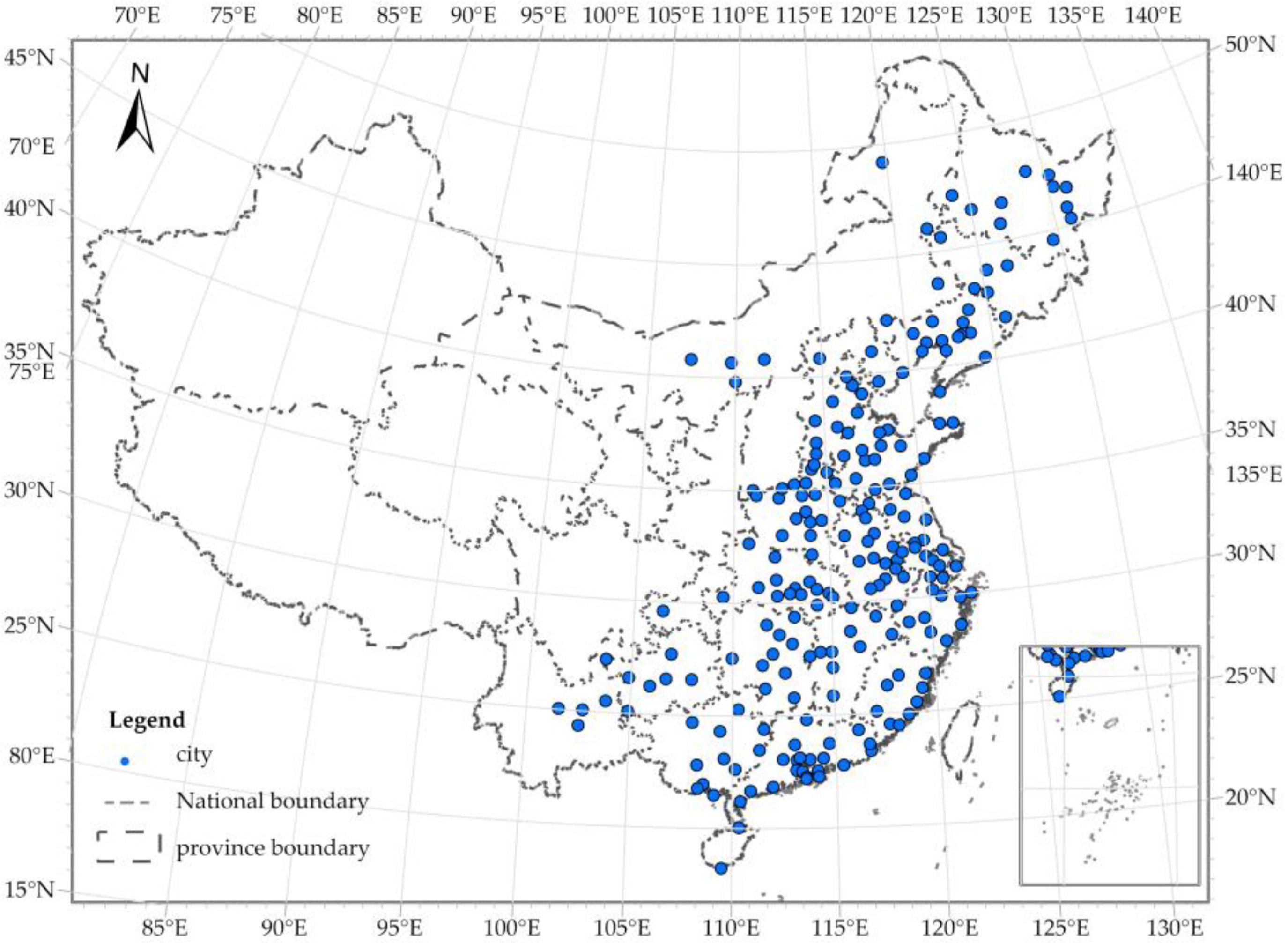

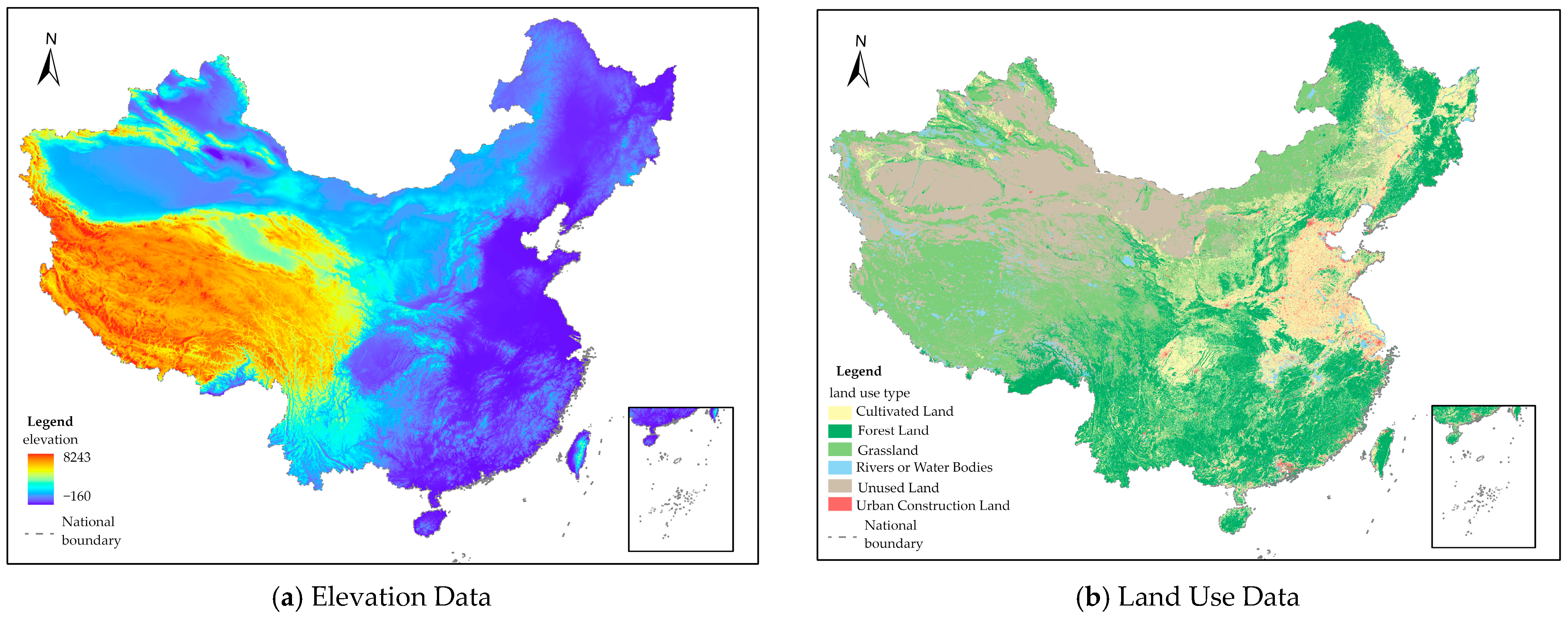
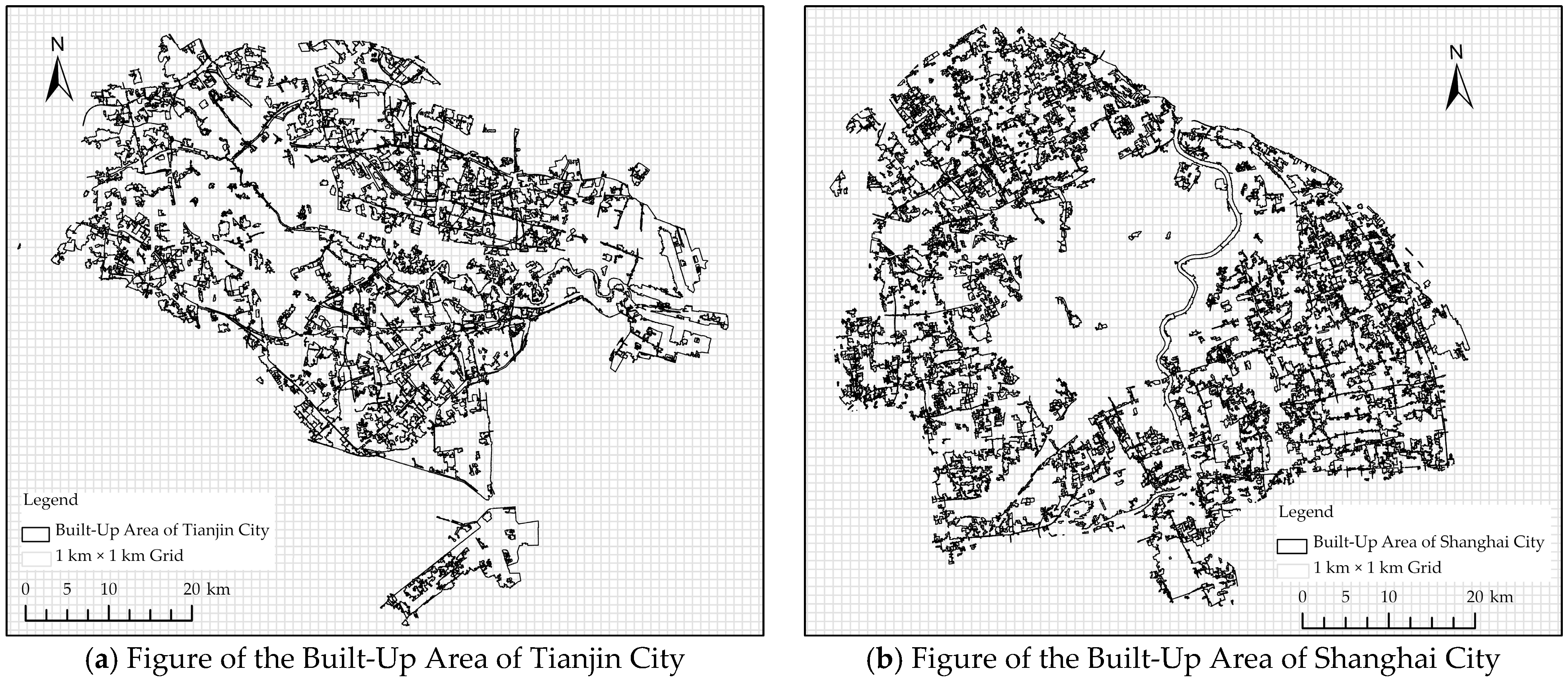

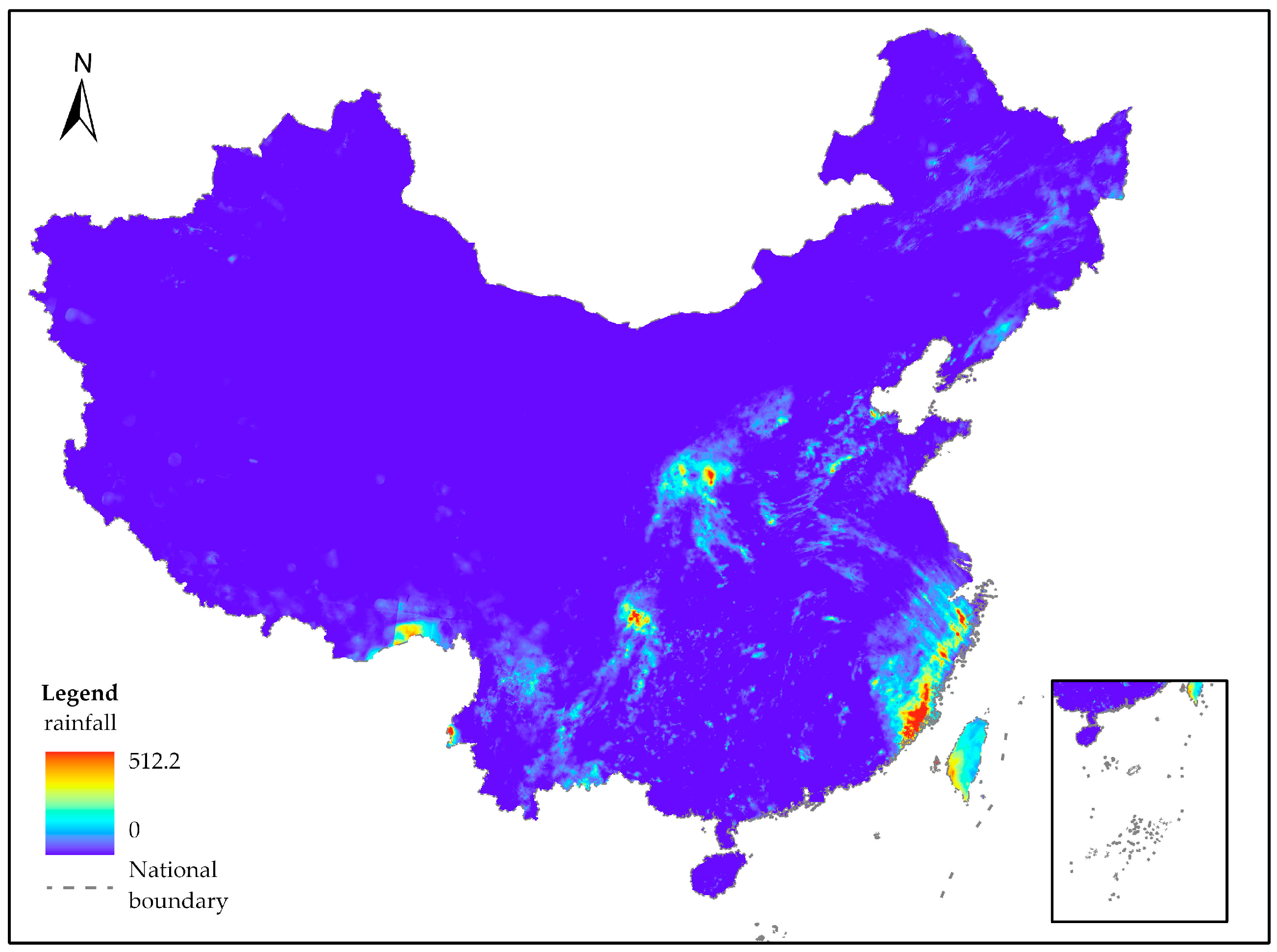
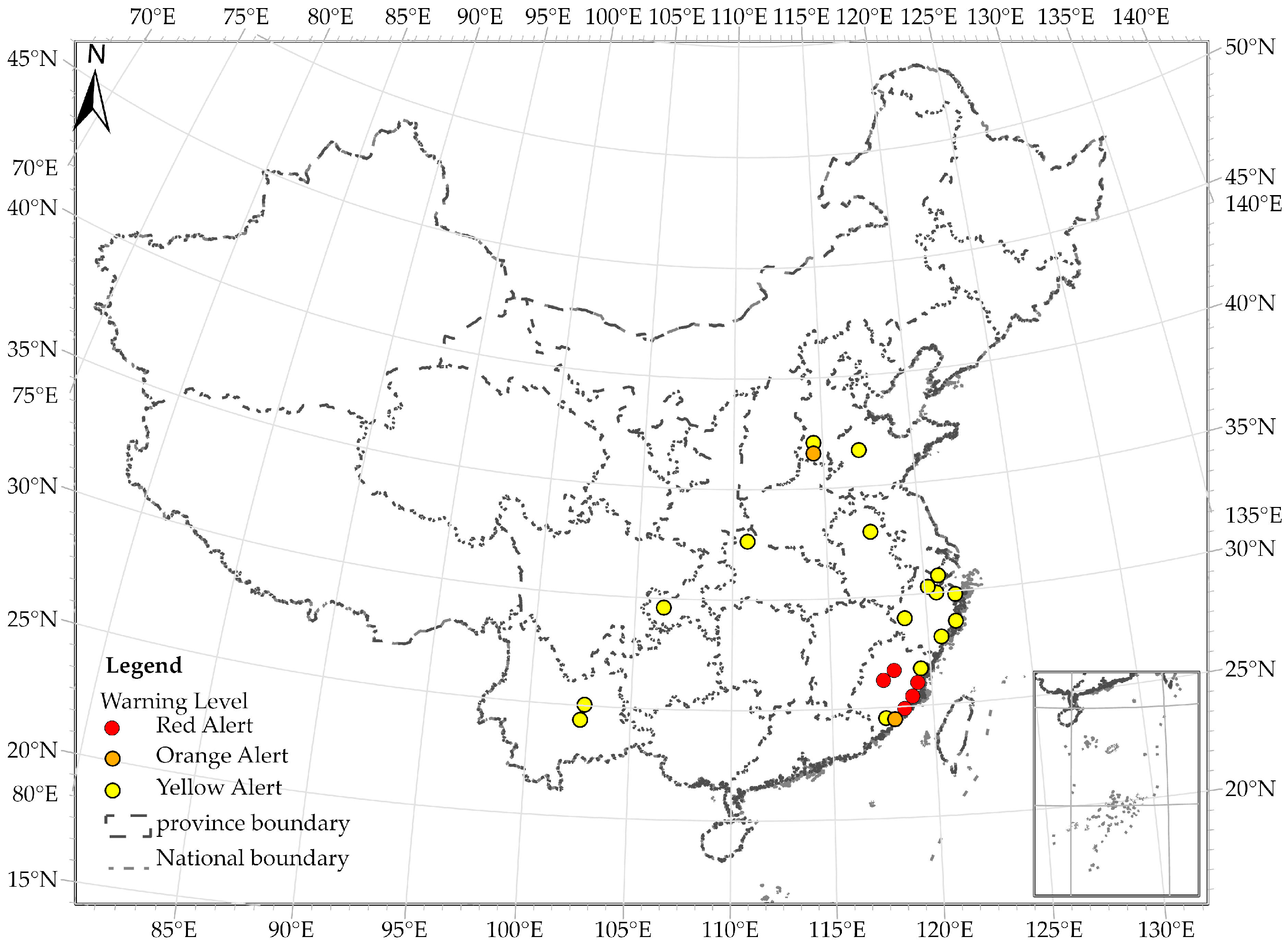
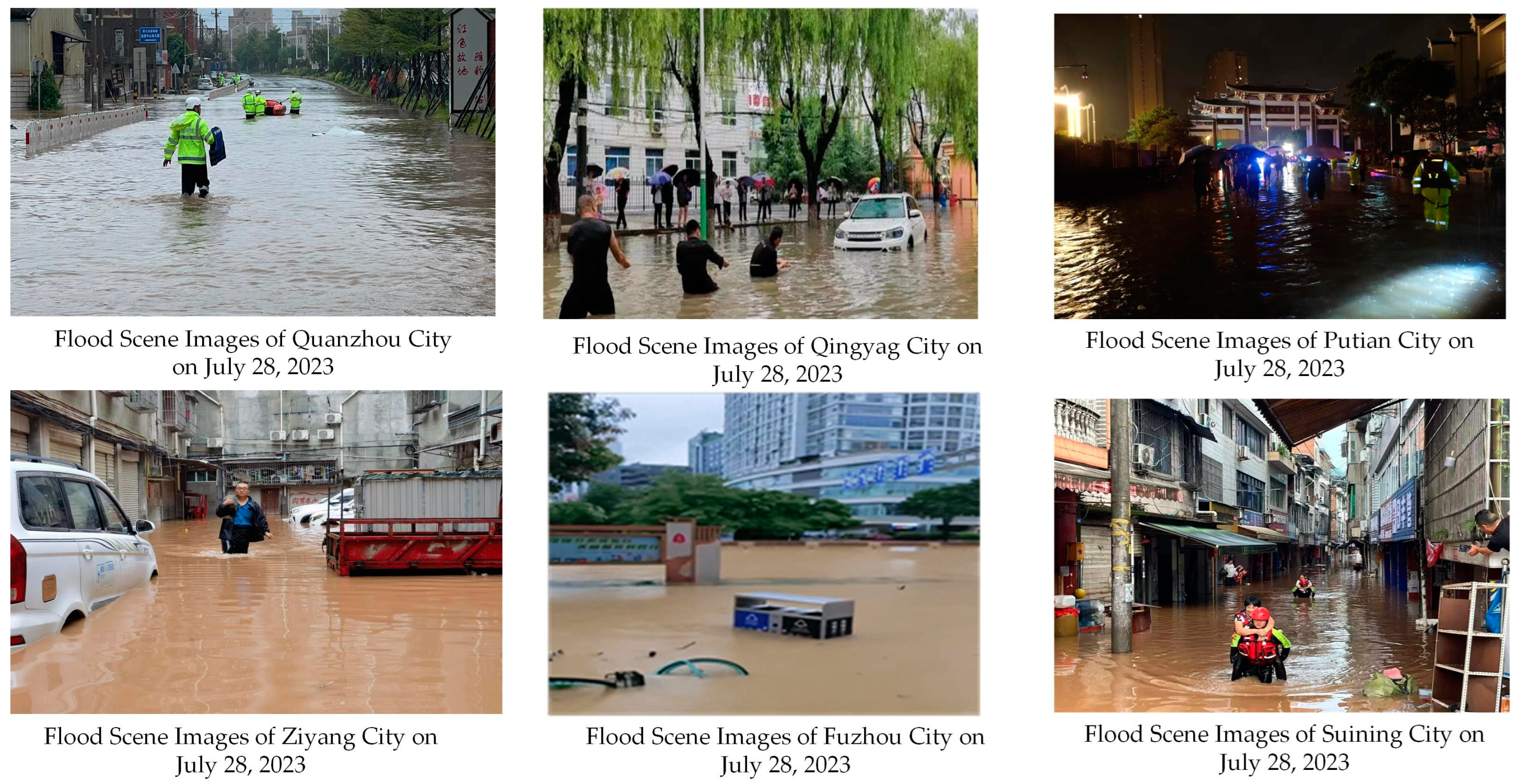
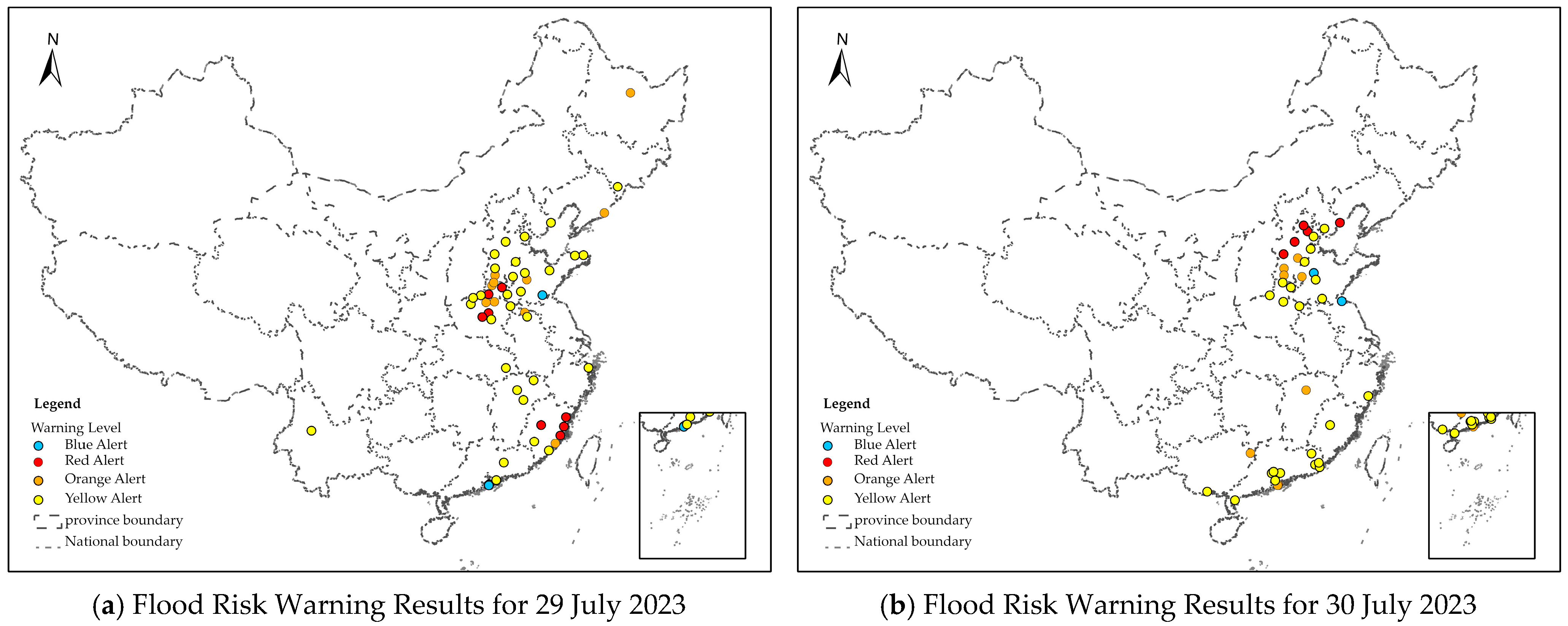
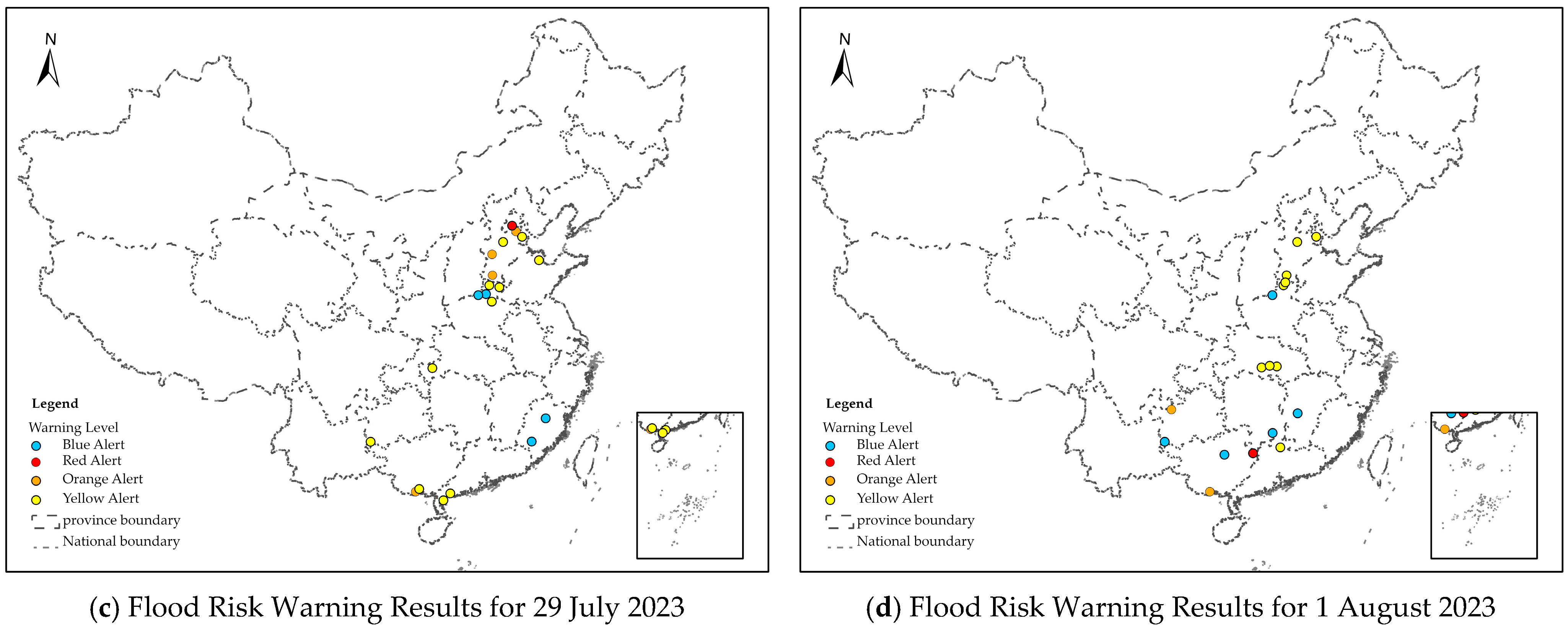

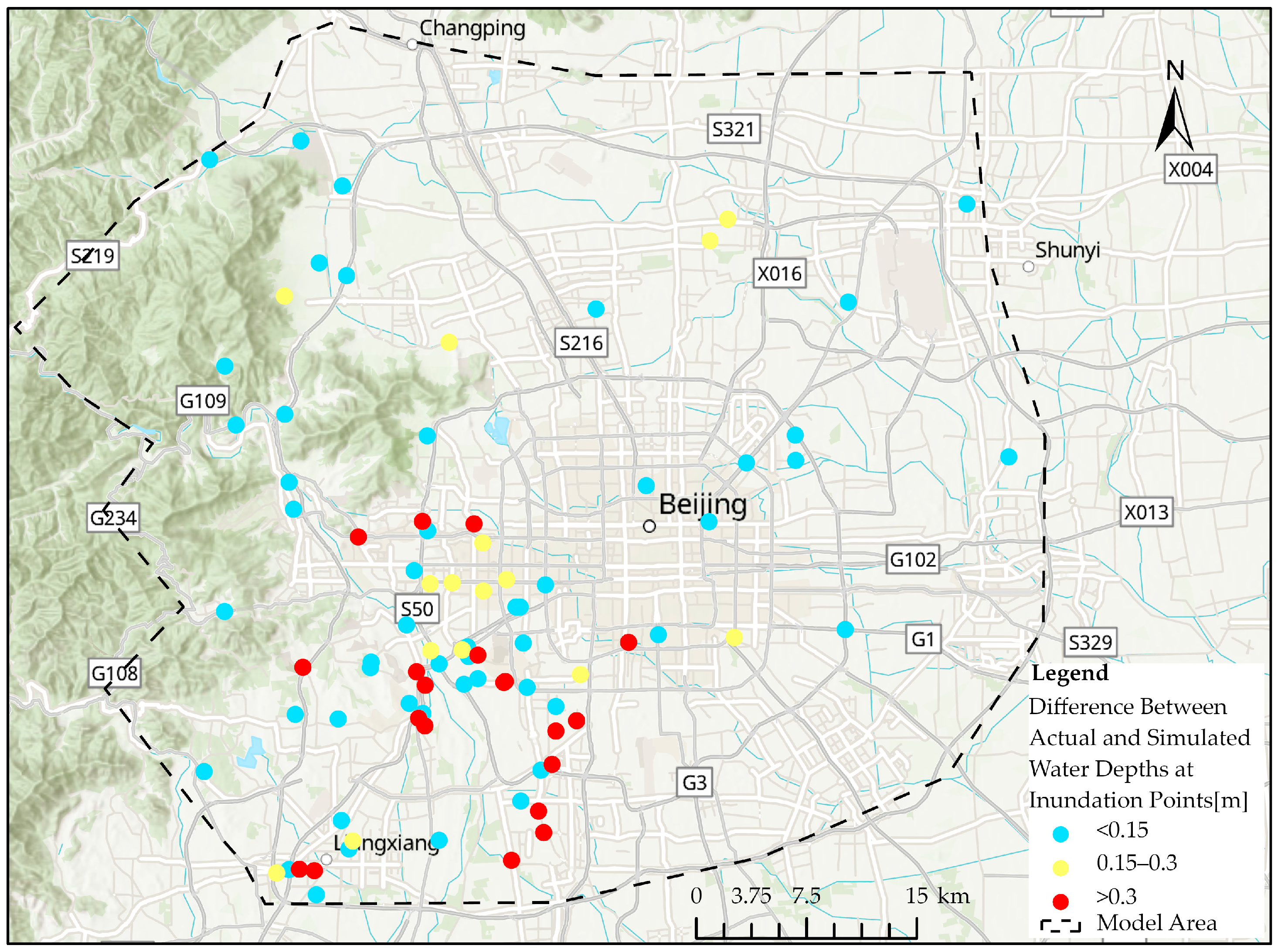
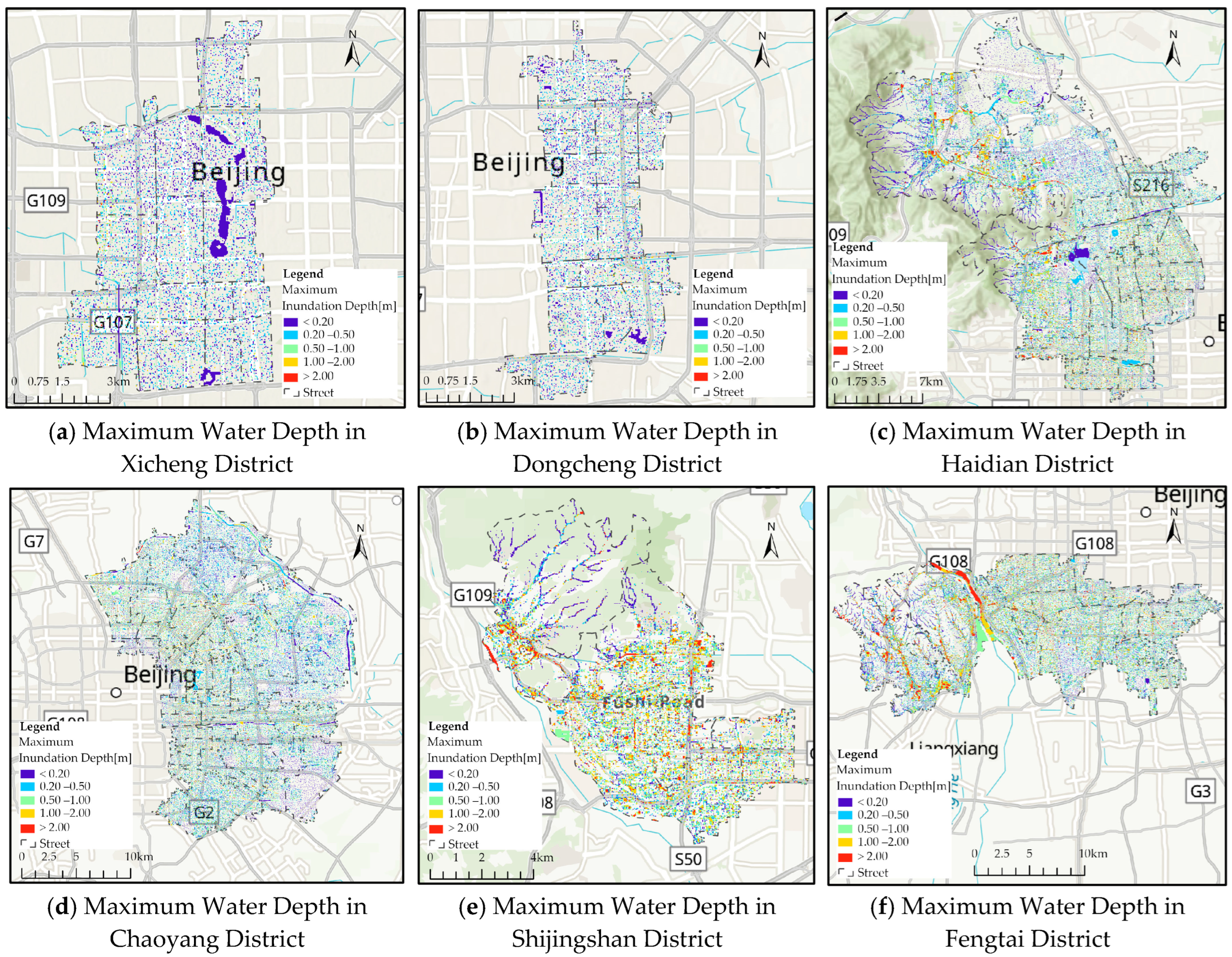
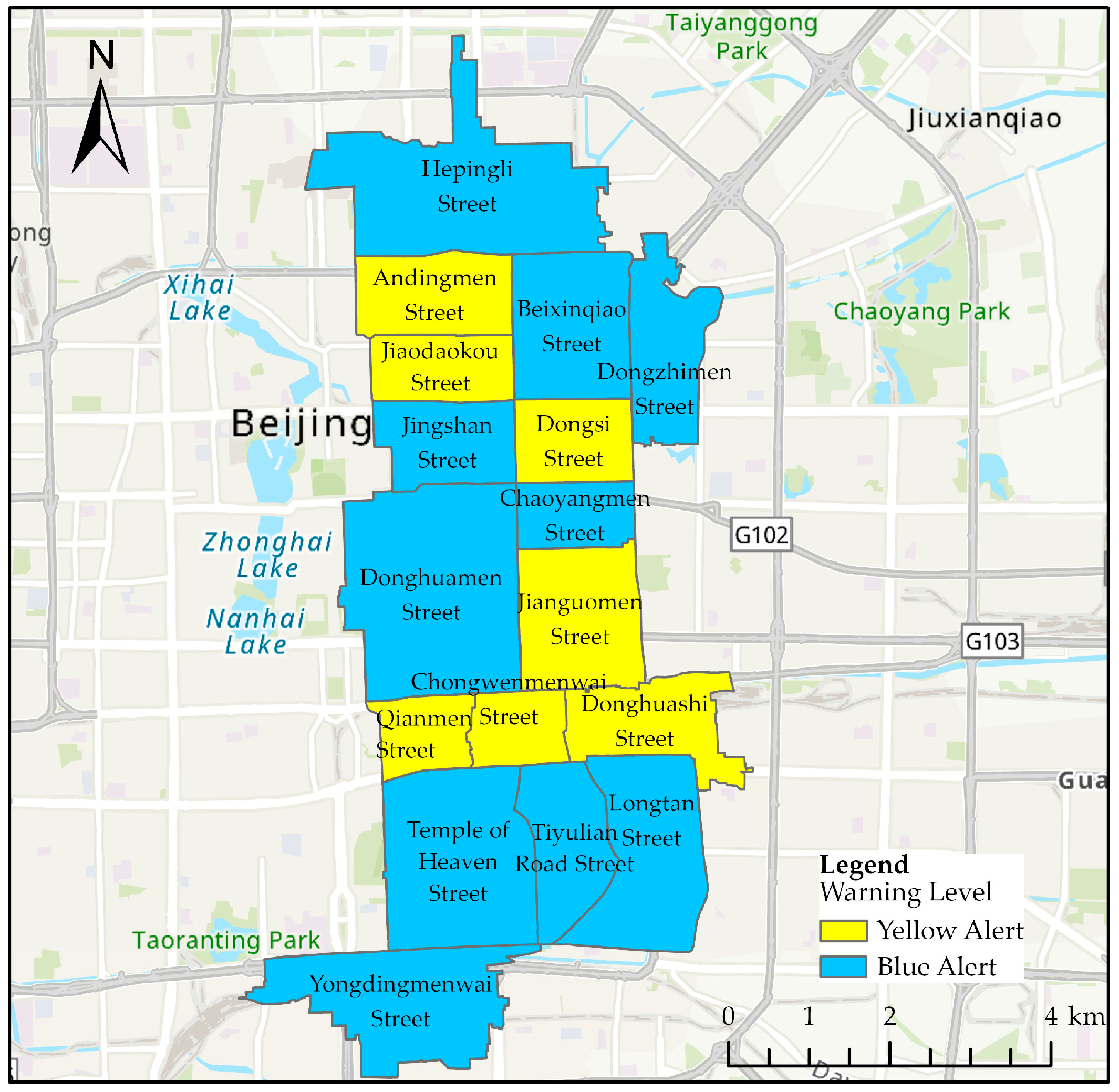
| City Size | Urban Area Type | |||
|---|---|---|---|---|
| Central Urban Area | Non-Central Urban Area | Critical Areas in Central Urban Area | Underground Passages and Sunken Plazas in Central Urban Area | |
| Megacities and Supercities | 3~5 | 2~3 | 5~10 | 30~50 |
| Large Cities | 2~5 | 2~3 | 5~10 | 20~30 |
| Medium and Small Cities | 2~3 | 2~3 | 3~5 | 10~20 |
| Land Use Types | Manning’s n | f0 | fc | kd |
|---|---|---|---|---|
| Cultivated Land | 0.05 | 35 | 20 | 3 |
| Forest Land | 0.07 | 25 | 15 | 4.8 |
| Grassland | 0.045 | 30 | 20 | 3.2 |
| Rivers or Water Bodies | 0.025 | 0 | 0 | 0 |
| Urban Construction Land | 0.1 | 2 | 1 | 4.8 |
| Unused Land | 0.03 | 40 | 25 | 4.8 |
| Serial Number | Warning Level | Urban Flood Risk Warning Threshold for Administrative Districts |
|---|---|---|
| 1 | Blue Alert | 5 cm ≤ H, and the area with inundation duration ≥ 1 h accounts for ≥10% of the built-up area. |
| 2 | Yellow Alert | (15 cm ≤ H, and inundation duration ≥ 1 h + 5 cm ≤ H, and inundation duration ≥ 3 h) ≥10% of the built-up area. |
| 3 | Orange Alert | (30 cm ≤ H, and inundation duration ≥ 1 h + 15 cm ≤ H, and inundation duration ≥ 3 h) ≥10% of the built-up area. |
| 4 | Red Alert | (50 cm ≤ H, and inundation duration ≥ 1 h + 30 cm ≤ H, and inundation duration ≥ 3 h) ≥10% of the built-up area. |
| Area | max_h > 0.2 m | max_h > 0.5 m | max_h > 1 m | max_h > 2 m | Warning Level |
|---|---|---|---|---|---|
| Xicheng District | 8.89% | 2.93% | 0.52% | 0% | Blue Alert |
| Dongcheng District | 9.36% | 3.09% | 0.53% | 0% | Yellow Alert |
| Haidian District | 16.61% | 10.35% | 4.55% | 1.01% | Red Alert |
| Chaoyang District | 17.59% | 9.56% | 3.06% | 0.46% | Orange Alert |
| Fengtai District | 25.18% | 17.67% | 8.75% | 2.59% | Red Alert |
| Shijingshan District | 20.49% | 15.45% | 8.96% | 2.55% | Red Alert |
Disclaimer/Publisher’s Note: The statements, opinions and data contained in all publications are solely those of the individual author(s) and contributor(s) and not of MDPI and/or the editor(s). MDPI and/or the editor(s) disclaim responsibility for any injury to people or property resulting from any ideas, methods, instructions or products referred to in the content. |
© 2025 by the authors. Licensee MDPI, Basel, Switzerland. This article is an open access article distributed under the terms and conditions of the Creative Commons Attribution (CC BY) license (https://creativecommons.org/licenses/by/4.0/).
Share and Cite
Gu, Q.; Chai, F.; Zang, W.; Zhang, H.; Hao, X.; Xu, H. A Two-Level Early Warning System on Urban Floods Caused by Rainstorm. Sustainability 2025, 17, 2147. https://doi.org/10.3390/su17052147
Gu Q, Chai F, Zang W, Zhang H, Hao X, Xu H. A Two-Level Early Warning System on Urban Floods Caused by Rainstorm. Sustainability. 2025; 17(5):2147. https://doi.org/10.3390/su17052147
Chicago/Turabian StyleGu, Qian, Fuxin Chai, Wenbin Zang, Hongping Zhang, Xiaoli Hao, and Huimin Xu. 2025. "A Two-Level Early Warning System on Urban Floods Caused by Rainstorm" Sustainability 17, no. 5: 2147. https://doi.org/10.3390/su17052147
APA StyleGu, Q., Chai, F., Zang, W., Zhang, H., Hao, X., & Xu, H. (2025). A Two-Level Early Warning System on Urban Floods Caused by Rainstorm. Sustainability, 17(5), 2147. https://doi.org/10.3390/su17052147






